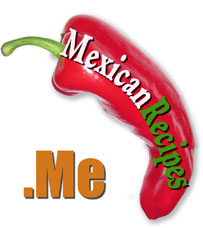Basic things you should know before you start to cook authentic mexican food
To go back to the mexican recipes page, click that link.
Please, should you come across such a procedure that you would like added here or explained in detail, send us a quick request and we will do our best to post it here, to the best of our knowledge.
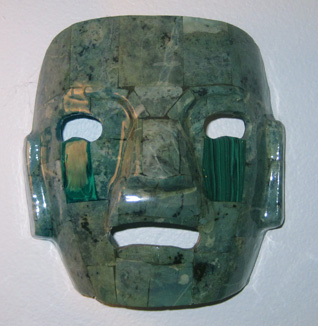
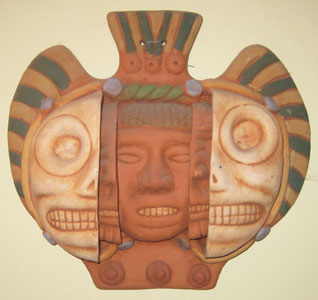
A practical guide on how to fry corn tortillas
It's called a habanero chile, not habañero!
How to make chicharrón en salsa roja, for your Tacos
Easiest way I found to cook beans, using the pressure cooker
What are 'hierbas de olor', exactly?
What are tomates verdes, also known as tomatillos?
The famous chipotles in adobo... meet your new best friend.
On your "To Buy" list: a Comal
The Nopales, a cactus with a history
Accept this fact about mexican cheese!
Now some good news about mexican cheese...
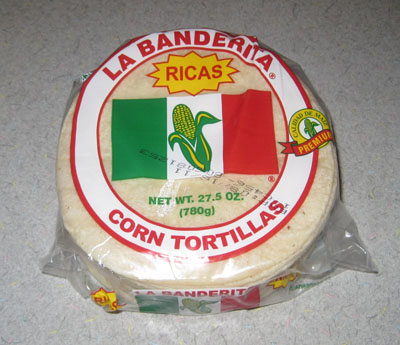
Find a place to buy genuine, fresh Corn Tortillas: the real thing!
The real and traditional tortilla from meso-american civilizations is made out of corn. Unfortunately, when south-american fellows began to migrate to the US and other richer countries in hopes to ameliorate their living standards, some switched to flour tortillas seeing this change as a move upwards, seeing the flour tortilla as the fancier replacement from their homeland tortilla. We are today realizing the health and taste benefits whole corn tortillas have over the white flour ones. And that is not even my main reason for avoiding flour tortillas: Corn tortillas taste better! If you want to make enchiladas or tacos that taste like the real thing corn tortillas are the way to go...
You can fry corn tortillas, they are much more versatile and have been in use for more than 2000 years. Unfortunately some North American supermarkets have opted to offer only the flour tortilla; probably for logistical and economic reasons. Why don't these supermarket food chains get it? You can find corn tortillas at your closest latin foodstore, among many other things you will need for the mexican recipes found on this site, along with a nice exotic experience, meet friendly people and a chance to practice your spanish!
Also one problem frequently raised with the corn tortillas is that they crack or break when rolled or folded... the solution is to heat them up considerably: for this you can microwave them, wrapped in a damp cloth; you also can fry them in oil or even fry them without oil: when submitted to a very high temperature, their texture changes and they suddenly become pliable. If you are not concerned too much about fat fry them in hot oil for a few seconds per side which is enough to make them pliable; we discuss this below.
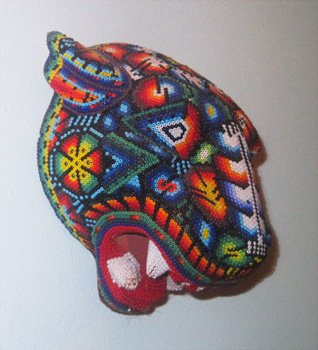
Frying Corn Tortillas
This is an undeniable fact about the corn tortilla: to become pliable and render their full flavor, they need to be brought to a very high temperature before serving. Such heat levels can be achieved by many different ways, but we will discuss here the frying in oil process... Frying also helps tortillas that aren't 100% fresh.First let's begin by saying that frying anything in oil can be dangerous. There are numerous text articles written on the internet on how to deal with a kitchen oil fire so I won't expand with this here; just be ready and know what to do if it happens.
Frying your tortillas will add a complete new flavor to your tortillas, and many mexican recipes require it.
The type of Oil to use when frying your tortillas in: pick an oil with a high smoke temperature point. I personnally recommend using canola oil. Tortillas need an extremely high temperature to fry correctly.
- Begin by choosing a pan slightly larger than one tortilla, as you will be frying them one at a time. I use a nonstick pan for convenience, but mexicans often use what they refer to as a "Comal", which is like a flat and low walled saucepan; if you become serious about making mexican food, you will need one of these, they are commonplace and easy to find. If you do not use a comal, pour in just enough oil to cover the bottom of the pan, you don't need more.
- Bring your oil to heat using medium-high setting on your stove. As oil will not boil or show you in visible way it is ready, you can use a wooden spoon or a small tortilla piece; if when you stick it in you see some bubbles going up, your oil is probably ready. If your oil isn't hot enough your tortilla will just soak in the oil, and absorb oil; no cooking will take place. When proper oil temperature is achieved, lower the stove heat to medium.
- Using a kitchen spatula (or short barbecue tongs), place one tortilla in the oil. How long you have to fry them depends on the application; for tacos or enchiladas just 30 seconds per side.
- Flip the tortilla over. Once a tortilla has been in the oil for one minute and pulled out, if its texture didn't change and become crispier this means your oil isn't hot enough. As you are taking the tortilla out of the oil try to shake as much oil as possible back to the pan.
- Once removed from the oil and cool down they will gradually become crispier, so it is time to fill them with whatever you had in mind. Do not wait, as you won't be able to manipulate them as easily later on.
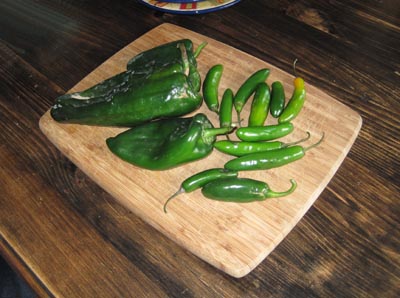
The Habanero chile
This is one of the most intensely hot chiles mexicans commonly use; its name comes from the Cuban city name La Habana, even though it is known to have originated from the Yucatan peninsula in Mexico... yes Mayans rock! The use of the ñ in habanero is wrong, as opposed to how the word jalapeño is written, for which using the ñ is correct; even though it may sound right to our english ears! Oh... did I mention this one is a very hot chile pepper? Before using it please make sure you know what you are doing...
The picture on the left shows my two favorite peppers: The big chiles in the picture are called poblano chiles, which are slightly hot, and then the small ones are serrano peppers which are much hotter, but still very bearable... as opposed to the habanero chile!!!!
How to make chicharrón en salsa roja (red sauce chicharrón) for tacos
For this recipe, you will need:One chopped onion, 2 cloves garlic, one chopped tomato, marjoram spice, habanero chiles, olive oil, Chicharrón meat (use bacon if this meat is not available where you live)
Preferably in a saucepan (casserole) that you can cover, to save you from making a terrible mess, mix the chopped onion together with the garlic and then add enough oil, do not overcook as we are not frying anything here. When the onion gets a little bit soft then add the tomato and cover your saucepan and cook for 5 minutes …
Once passed this time uncover and add the marjoram spice powder, the habanero chiles, stir the mixture, cover and let it cook under low fire. Once the tomato seems cooked, uncover the saucepan, add water (approximately fill until half the saucepan) break, crumble the chicharrón in the pan and cover again; bring to a boil. While you cook the Chicharrón add more water if necessary so that the recipe never runs dry. Once done check saltiness, but keep in mind the chicharrón generally is a salted meat so adding more salt won't be necessary, except of course for those cases when it is necessary!
Quickest and easiest way to cook dry beans: using the pressure cooker
This way of cooking beans truely is something of a miracle. Not all Mexicans
know this one... On the stove, beans need to simmer during 3 hours in order to make them palatable... not with this method!
Soak your beans overnight; put 2 cups dry beans for 6 cups water in a container that can be closed with a lid and let them soak overnight; do this for best results, but in absolute rush this step can be skipped altogether...
Next day, discard water you have used for soaking the beans and clean them in running cold water.
Transfer those beans to your pressure cooker; fill the pressure cooker with water until the water level reaches a good two inches above the beans.
Press in some garlic, in the water; add one tablespoon salt
Close the pressure cooker; for those unfamiliar with safe operation of this very useful tool, please refer to instructions.
Turn up the heat to high setting; wait about 2-3 minutes for the steam to start flowing out of the pressure cooker.
Once the steam has started to force itself out, set the timer to 16 minutes and lower the heat setting a notch or two.
Wait the whole 16 minute period, then turn off the heat and wait for the cooker's internal temperature to drop (this is important!)
You can pour cold water over the cooker to help lower its internal pressure.
Open the cooker and there you are: cooked beans! Carefully try one to see if the cooking time was enough; if they still aren't quite done,
add a bit more water, close the cooker and turn up the heat to the max again until steam starts flowing once more.
If they weren't fully cooked the first time, we certainly can't be very far; so another 2-3 minutes pressure cooking time should do it.
How you prepare your beans once cooked is entirely up to you; but to have that mexican flavor, I add 2 tablespoons cumin, 1 tablespoon salt,
put in some chopped chipotles along with some more garlic... but that's just me.
Enjoy your beans; 16 minutes instead of 3 hours isn't bad...
What are those famous mexican 'hierbas de olor'
hierbas de olor are a combination of certain spices. If you read mexican recipes from spanish sites, you will come across this ingredient, several times. They are a combination of the following spices from plants, still attached to their branch and often tied up in a bouquet: laurel, thyme, oregano and/or marjoram are a very popular spice combination in Mexico; but there is no official and definitive mix or mix-ratio. It is used a bit like the french "bouquet garni" where the bouquet is left in a sauce or recipe while cooking, then thrown out after. This spice combination is very peculiar of mexican cuisine; it is used in a wide variety of dishes such as soups, meats, poultry, pastas, etc.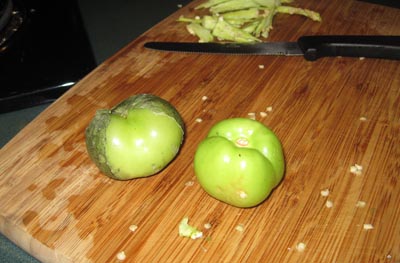
What are green tomatoes, tomates verdes or also tomatillos?
This is the basic ingredient behind most of the green salsas... a very basic ingredient, frequently used in many mexican recipes. This fruit belongs to the same family as the red tomato we all know however it is a different variety, with its own distinct taste.
For those who aren't already acquainted with this ingredient, you can recognize it by its unique husk that protects it; the one on the left of the picture still has part of its husk on. You remove and discard it before cooking the tomatillos. People sometimes mistake the tomates verdes or green tomatoes ingredient with unripe red tomatoes, which are also green but are quite different! Many mexican recipes also use unripe tomatoes; I know the difference is obvious to a person used to cooking mexican food, but just remember that when I ask for green tomatoes in a recipe, it is this fruit I am referring to. I will do my best when describing recipes needing one or the other on this site to clearly specify which one am I talking about.
The chipotles in adobo...
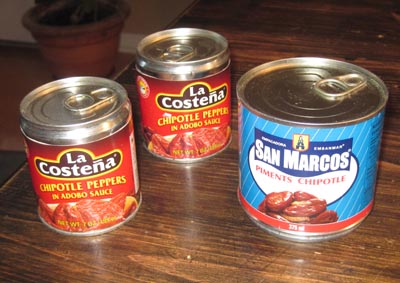
I'm usually not the one to recommend ready-made ingredients... but this one is as convenient as it does contribute greatly to many mexican recipes. The chipotle is actually a dried jalapeño chile that has also been smoked with a special kind of wood; they have this smokey aroma that combines well with other flavours such as cilantro or cumin used in many mexican recipes, you can buy them like any other dried chile. In canned form, there is one preparation that is extremely useful: in adobo. Adobo is a generic term that means a marinade, but when it comes to chipotles in adobo, the adobo described is a more specific kind. From the chipotles in adobo can, you will use both the chipotles (usually chopped) and the adobo itself as ingredients.
The tortillas' best friend: the Comal
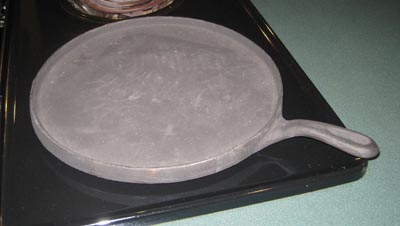
Introducing a very mexican "Comal"; right out of the box it looks like the one you see on the picture on the right... this is an exciting time for me: I have bought my first Comal! Well theoretically, if I take care of it the way I should, this should be my last Comal as well... The Comal is a crude piece of cast iron and it is what you need for working with tortillas. You cannot deep fry tortillas in oil using a comal because it isn't designed to hold any quantity of oil, but its completely flat surface makes perfect contact with the stove heaters, which translates into an even heat distribution across its surface. Essentially this flat surface with its even heat distribution operates like a griddle. Do not leave a comal in water; it will rust. Before using it the comal needs to be seasoned, just like any cast iron pan...
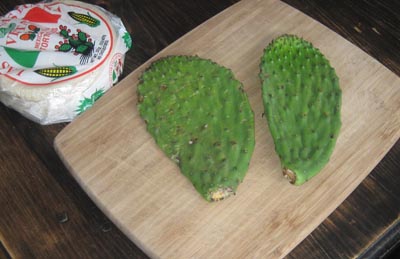
The Nopal cactus: a symbol of Mexico, and of mexican food
This is an edible plant, but you must remove its spines of course, and the nopal is part of many authentic mexican recipes...
Accept this fact about mexican cheese and mexican cheeses!
Every mexican cheese carries its distinct personality, texture and aroma which are sometimes found in other cheeses, but my point is that it is difficult to substitute a mexican cheese from a recipe and try to keep the recipe's original taste.
Also when Mexicans sprinkle cheese over their tacos or enchiladas, its usually crumbled, not grated: to crumble a cheese you need a crumbly cheese (queso Panela, queso Oaxaca), and it can be crumbled with your bare hands, or by chopping it up with a knife...
So the problem is this: while there are many latin products stores in every major cities, it is difficult for them to maintain a proper stock of mexican cheeses if there isn't a big mexican community nearby, the effect of this is that these cheeses will be sometimes grossly overpriced and hard to find. But wait! This battle is not lost yet...
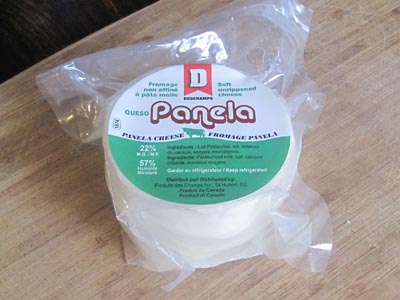
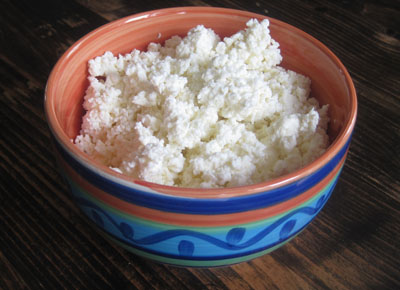
Great News!-
You can make your own mexican cheese at home...
Queso fresco is a very simple cheese that is easy to crumble, great for presenting mexican food the festive way it is meant to be presented. It is also easy to make, although slightly time consuming; here is how I make it: making queso fresco.
Privacy policy. Click on the red chile to get back to home page!
